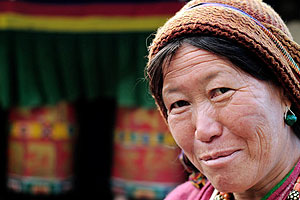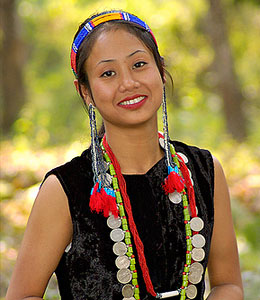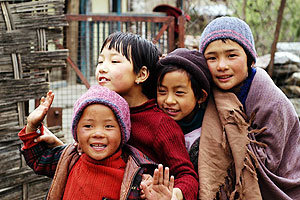|
|
|
Arunachal Pradesh People |
|
|
About
People of Arunachal Pradesh
About 26 major indigenous tribes and various sub-tribes
resides in 3649 scattered villages of Arunachal Pradesh.
Although, these tribal groups constitute the total population,
but the density of population is very less. These tribes are
mainly the migrants from Tibet-Burma, who colonized vacant
lands in the longitudinal valleys, from the north and east. It
was difficult for them to spread laterally across the land, so
the skillfully crafted cane bridges helped them to access the
rivers. The people are simple, friendly, hospitable and follow
the traditional lifestyles. These tribes have a certain |
 |
|
distinct
characteristic in language, dress and costume and have a rich
cultural heritage. Some of the major Buddhist communities like
the Mongpas and Sherdukpens of Bomdila and Tawang in West
Kameng and the Membas (Siang) are located along the northern
and eastern area. They belong to the Mahayana stream of
Buddhism. The Khamtis, Singpos and Tangsas originally migrated
from Thailand and Myanmar (Burma) and follow Hinayana Buddhist
practices. The tribes of Arunachal Pradesh are divided into
different groups on the basis of their
socio-politico-religious affinities, living their lives
independent of each other. The pattern of their lifestyle is
same and they follow the same occupation. The societies are
casteless and governed by chiefs. The adults were grouped
according to their age for distinct social functions. The
young are organized around dormitory institutions to follow
the instructions of the older generation. The society is
patriarchal and primogeniture and the fundamental laws of
inheritance with variations are not uncommon. The people are
highly democratic, and each tribe has its own organized
institutions that maintain law and order, decide disputes and
take up all activities for the welfare of the tribes and the
villages. The members constituting these organizations are
selected by the people. The Tribal Research Centre is deeply
involved in the preservation of Arunachal’s tribal cultural
expressions such as music, dance, folklore, etc.
|
|
|
|
Some of
the major tribes are the Wanchos, Noctes, Khamtis,
Singphos, Tangsas, Adis, Akas, Apatanis, Mishis and
Nyishis. The Wanchos resides in the south-western part
of the Tirap district bordering Nagaland. These people
are fond of wearing decorated headgears and heavy
strings of beads on the neck, arms, legs and ears. The
Noctes resides in the central part of the Tirap
district, to the north of the Wanchos. These people have
a long and traditional contact with the people of the
neighbouring plains. Many of them are Vaishnavites.
Tangsas is a common name for the group of people that
consists of the Lungchang, Moklong, Yugli, Lungri, Have,
Moshong, Rundra, Takhak, Ponthi and Longphi. Each group
is subdivided into a number of exogamous clans. These
tribes occupy the Changlang district along the
Indo-Myanmar front. The Singphos lives on the banks of
Teang and Noa Diking rivers and extend towards the
southeast into the land of the Khamptis. They are a fine
athletic race with developed Mongolian features. They
are expert |
 |
|
|
blacksmiths
and prepare iron implements of quality. The ladies are good
weavers. They are Buddhists. The Khamptis live to the south of
the Lohit district along the Kamlang, Dehing and Tengapani
rivers with the Parasuramkund to the northeast and Tirap
district of the south. The Khamptis are good craftsmen,
enterprising traders and skilful agriculturists. They are
Buddhists. The Mongpas are skilled weavers, traders and
agriculturists who also make indigenous hand-crafted paper
from plants discovered among the deep jungles. They also make
the beautiful carpets, painted wooden vessels and silver
articles. The gentle Sherdukpens are reputed for their folk
dances embellished by folk tales and religious themes. Their
Yak dance, Deer dance, Ajilhamu dance and Eagle dance are
mesmerizing. These people also make beautiful masks and as
well as periodically stage the pantomimes and mask dances. The
Apantanis, Hill Miris and Adis make beautiful articles of cane
and bamboo, and speak eloquently about their skill in
handicrafts. The shawls and Jackets of the Apantanis and the
Adis and shoulder bag and the Mishmi's coat are symbolic of
the high weaving talents and artistic sense of the people.
|
|
|
|
The
three main groups of the Mishmis are Idu, Miju or Kaman
and Digaru or Taraon. The Idus, also called as Chulikata
by the plains people, live in Dibang valley district.
With roughly 25,000 members, the Idu tribe is divided
into sections, each named after the river by the side of
which they live. It is by the manner of hair that the
Idus (Chulikatas) are distinguished from other tribes.
The front hair is combed down on the brow and then cut
straight across from ear to ear. The back hair is
collected in a knot. There are about 18,000 Mijus or
Kamans that live in the Lohit district, east of the
Taraons. Their dress is very long, colourful and
|
 |
|
|
durable. The
Kaman, specially the women, have an admirable sense of colour
and pattern. Agriculture is one of the main occupations of
these people. Taraon are also known as the Digarus. They are
also good agriculturists.
The tribes of
the East, West and Upper Siang districts together comprises of
"adis". They may be divided into three main groups, which are
Galos, Padams and Miwongs. Each of these groups can be
subdivided into a number of sub-groups. The dances are very
popular among the Adis. Their traditional dance is Ponung,
which is also religious in character. The Galos weave clothes
of highly artistic designs and their beautiful skirt has a
central pattern of black yarn netted in regular designs of
black and white. The Adis, Akas, Apatanis, Mishis, Nyishis,
Mijis still follow traditional tribal forms of worship. Their
animist practices are linked to the seasonal and agricultural
cycles. They also worship Donyi-Polo, the Sun and Moon gods. |
|
|
|
|
|
|
|
|
|
|
|
|
|
|
|
|
|
|
|
|
|
|
|
|
|
|
|
|
|
|
|
|
|